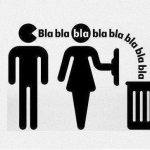by Jonathan Kujawa

“Meaningless! Meaningless!”
says the Teacher.
“Utterly meaningless!
Everything is meaningless.”
— Ecclesiastes 1:2
This spring I taught one of my favorite classes. Officially, it goes by the name of Discrete Math and covers various standard topics: sets, functions, basic logic, modular arithmetic, counting problems, graph theory, etc. Unofficially, it is our department’s boot camp for people who want to take advanced math classes.
Up through high school math, and even in most freshman and sophomore math classes, the goal of a math class is for students to be able to use standard tools to solve standard questions. We are teaching students to distinguish between a screw and a nail, and to know to twist one with a screwdriver and hit the other with a hammer. Most problems and techniques are chosen more for teachability and testability, than for being interesting or useful. What matters is The Answer. It is right or wrong, and it’s right because someone said so. We shouldn’t blame the teachers for this state of affairs. They suffer as much as anyone under our educational system.
But math is meant to be a creative, human activity. In Discrete Math our students are deprogrammed of their twelve years of bad math education. I teach it using a slow version of the Socratic method, sometimes called Inquiry-Based Learning. Students are given a well-chosen series of problems to solve, but many are ambiguous or open-ended. They collaborate, share ideas, present written and oral solutions, and they critique each other’s work. For students used to being force-fed, Clockwork Orange style, it’s liberating, exciting, exhilarating, and terrifying all at once.
The first challenge is to get the students to deeply internalize the fact that words have meaning. If we’re going to talk about even numbers, then we’d better all agree on which numbers are even. Is 104 even? How about -2, or 0, or π?
Worse, they discover there are no God-given definitions in mathematics. Students are always a bit shocked to realize it was people just like them who came up with the math they take for granted. Even the equals sign was invented by someone, after all. Definitions can be contentious.
What is a prime number? Should 1 be called prime? After all, it is only divisible by 1 and itself — the usual definition of a prime number. For centuries there was real debate over the primeness of 1. For years, some mathematicians considered 1 prime and some didn’t. Which worked okay as long as people made sure to say explicitly which school they followed. It wasn’t until the early twentieth century when there was finally a consensus that there are very good reasons to exclude 1 from the prime numbers.
It is up to us to decide and be explicit about the meaning of our words. This is wickedly difficult in the real world. On the very first day of Discrete Math, one of the problems I give is a classic from philosophy [1]. I ask the students to work in groups and come to a consensus definition of the word “table”. I explain we are looking for a definition which will precisely identify all the tables of the world. Every table should fit the definition and every non-table should be excluded. No matter how intricate, their definitions inevitably fail. From legless mid-century modern tables and repurposed wooden chests, to stools and trampolines, other students always find ways for the proposed definitions to fail.
In mathematics, we’ve adopted the Humpty Dumpty philosophy:
“When I use a word,” Humpty Dumpty said, in rather a scornful tone, “it means just what I choose it to mean – neither more nor less.”
— Alice in Wonderland
Every word must be given a fixed, precise definition. No fuzziness allowed. Without clarity in our words and ideas, progress cannot be made.
This attitude is one of the secrets to math’s superpowers. Being pedantic is a feature, not a bug. The physicist Eugene Wigner once wrote an essay entitled “The Unreasonable Effectiveness of Mathematics in the Natural Sciences” in which he marvels, “the mathematical formulation of the physicist’s often crude experience leads in an uncanny number of cases to an amazingly accurate description of a large class of phenomena”. The hardest and most important part of many problems is to put it into the uncompromising language of mathematics.
Keith Devlin tells a story of when he consulted on national security issues in the aftermath of 9/11. In his first presentation, Dr. Devlin never made it past his first powerpoint slide.
I took the oh-so-obvious (to me) first step. “I need to write down as precise a mathematical definition as possible of what a context is,” I said to myself….
The fairly large group of really smart academics, defense contractors, and senior DoD personnel in that meeting room spent the entire hour of my allotted time discussing that one definition…. what the discussion brought out was that all the different experts had a different conception of what a context is, and how it can best be taken account of – a recipe for disaster in collaborative research if ever there was….
As a mathematician, I had done nothing special, nothing unusual. It was an obvious first step when someone versed in mathematical thinking approaches a new problem. Identify the key parameters and formulate formal definitions of them. But it was not at all an obvious thing for anyone else on the project.
It is important to recognize the very act of setting definitions can greatly influence the end result. On a recent exam, I gave my Discrete Math class a problem which involved randomly selecting a word of six or more letters. I intentionally left the problem a bit vague. Students were asked to specify the assumptions they made and the answer could be wildly different depending on those assumptions. You might assume “word” means an arbitrary string of letters or a word in a standard English dictionary, you might count “y” as a vowel, and you might choose to count different spellings of the same word as different, or not.
A famous example of this phenomenon is the Broken Stick Problem: Assume a stick is broken at random into three pieces. What is the probability that the pieces can form a triangle? On first glance, this seems black or white. While doing the actual computation might be tricky, the question seems clear enough. Sometimes (e.g. if you break the stick into two very short pieces and one long piece) it’s not possible to make a triangle, and sometimes it is. I was deeply disturbed in my intro to probability class to discover that different, entirely reasonable, ways of turning the question into mathematics leads to substantially different answers [2]! We talked about this and related problems here at 3QD last year.
Besides mathematics and philosophy, definitions are crucial in law. This was my go-to example of the importance of definitions in my Discrete Math class. We’ve all watched enough cop shows to know there is a big difference between first- and second-degree murder charges. Whether you’re guilty (or not!) of battery, assault, or aggravated assault depends on the precise meaning of these words in the jurisdiction in which you are charged.
As my Discrete Math class wound down this semester, I was once again reminded of the real world importance of precision and clarity in our language. The linguist Janet Randall and her collaborators are studying the impact of the turgid, legalistic style of jury instructions [3]. If you are a juror in Massachusetts who is unsure of what constitutes negligence, you’ll receive the following helpful guidance:
Negligence is the failure of a responsible person, either by omission or by action, to exercise that degree of care, diligence, and forethought which, in the discharge of the duty then resting on him or her, the person of ordinary caution and prudence ought to exercise under the particular circumstances. It is a want of diligence commensurate with the requirement of the duty at the moment imposed by the law…
Convictions are regularly overturned. How many erroneous verdicts are due to jury members not knowing the definition of “beyond a reasonable doubt” or the difference between that and “preponderance of evidence”?
 It is important we have a common understanding of the things we discuss. We would all do well to be pedantic once and awhile. Especially in this age of “fake news” and clickbait headlines, when so many words seem to be on the verge of losing all meaning.
It is important we have a common understanding of the things we discuss. We would all do well to be pedantic once and awhile. Especially in this age of “fake news” and clickbait headlines, when so many words seem to be on the verge of losing all meaning.
